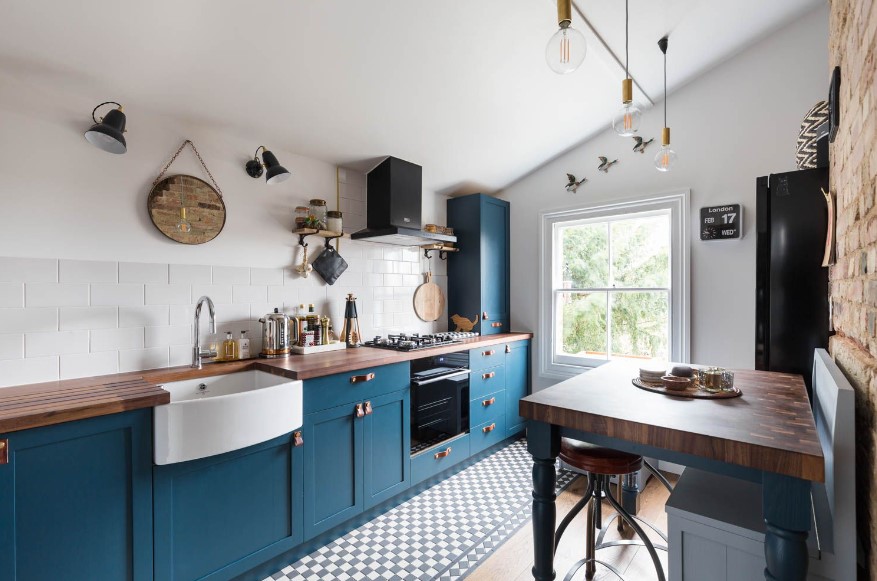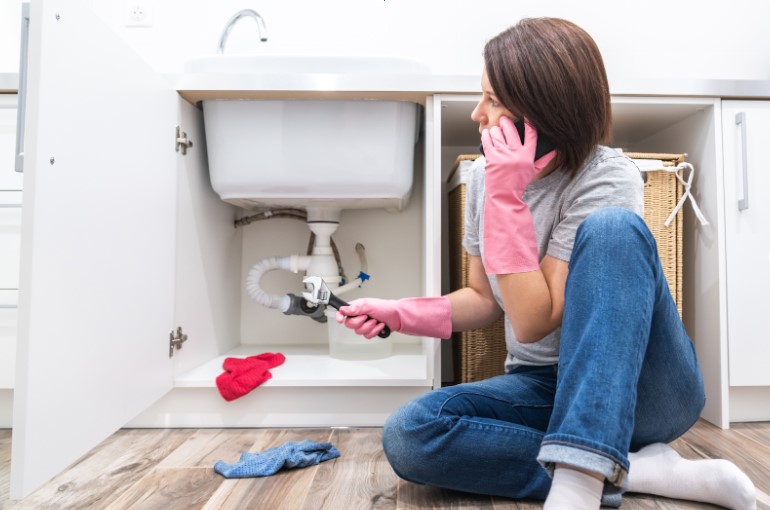How to Declutter a Small Kitchen

Decluttering a small kitchen can make a big difference in the space’s look and functionality. You can create a more efficient and enjoyable cooking environment by eliminating unnecessary items and finding creative storage solutions.
To help you with that, here are our best tips and tricks:
Use Vertical Storage Solutions
In the quest to declutter and optimise a small kitchen, consider the power of vertical storage. A hanging rod on the side of your kitchen island or wall can add much storage space to an otherwise unused area.
This simple solution allows you to hang various kitchen essentials, from utensils and stylish baskets to cutting boards and handy dish towels.
If you go vertical, you’ll free up precious countertop and cabinet space while keeping frequently used items within arm’s reach. You can organise your kitchen in a practical, visually pleasing way while making the most of every square centimetre.
So, whether it’s your trusty spatula or a decorative fruit basket, let vertical storage be your ally in the battle against kitchen clutter.
Purge and Clean Your Fridge
Clean your fridge. Take inventory and get rid of items that smell bad and are past their expiration date. Devise recipes that can make use of foods close to expiring. This is a smart way to minimise food waste and make the most of your pantry.
As a pro tip, arrange open food items towards the front of your fridge. This minor adjustment will encourage you to use them before reaching for unopened ones, reducing the chance of accidentally discarding or throwing out ingredients.
Streamline Your Mug Collection
We all have that one kitchen cabinet overflowing with mugs, each holding a unique memory or sentimental value. But in the quest for a clutter-free kitchen, it’s time to tackle the mug collection.
Start by gathering all your mugs and laying them on a table, creating a visual inventory of your cherished cups.
Now comes the decision-making process. Keep only the mugs that genuinely resonate with you. Pick the ones that you really like and make the perfect cup of coffee or tea even more enjoyable.
Consider passing the rest of your mugs on to new homes by donating them to charity shops or gifting them to friends or family.
This way, you can avoid cluttering your kitchen while ensuring that the mugs you keep bring you joy and functionality every day.
The Pantry Challenge
When it comes to reducing kitchen clutter, one of the most effective methods is participating in the “Pantry Challenge.” It encourages you to use up those forgotten pantry ingredients that sit unused.
These canned and dry goods, while neglected, can become the stars of your culinary adventures.
The challenge is simple yet effective – challenge yourself to craft delicious meals using the ingredients you’ve found collecting dust in your pantry.
You are reusing often-overlooked ingredients, minimising clutter and reducing food waste all at the same time. Both your kitchen’s organisation and your taste buds will benefit from it.
So, reach for those cans of beans, pasta, and rice, patiently waiting for their moment in the spotlight. Cook hearty soups, creative casseroles, or international-inspired dishes with them.
You can free up valuable pantry space and stimulate your culinary creativity as part of the “Pantry Challenge”.
Declutter Cupboards and Countertops
Pick a decluttering strategy. The best decluttering approach is finding a system that suits your lifestyle. If you’re limited on time, work in categories and sections. Wipe down all surfaces and keep them clean.
One of the fastest ways to make your home look less cluttered is to clean all flat surfaces, like countertops, cupboards and tabletops. Put everything on the floor and only add back essential items. Each item should have a designated place.
Once you start designating spots for specific items, it will become easier to put things back where they belong.
When it comes to decluttering, there are a few questions you can ask yourself to help determine if the item should stay or go.
- Do I use this? If you have to think about your answer, it’s likely that you don’t need the item.
- Is this product still good? Almost all products have expiration dates. If the texture, colour, or scent is off, it’s probably gone bad and should be discarded.
- Would I buy this today? Ask yourself if you still like the item. Is it adding beauty or function to the space, or just adding to the clutter? Does it help make your life easier or better?
Use Smart Storage Solutions
Find smart storage solutions. Invest in closed storage pieces to organise and hide the clutter so the surfaces stay clean. You could try cabinets, pantry organisers, or even stylish armoires. If you opt for closed storage, you keep items out of sight, creating a clean and visually appealing kitchen.
But don’t stop at the obvious choices; think outside the box—literally. Use the untapped potential of discreet corners in your kitchen. Corner shelving or pull-out drawers can transform awkward spaces into valuable storage real estate.
Additionally, consider furniture pieces that do double duty. You can also use multipurpose furniture to keep clutter at bay and make your house more functional, such as kitchen islands with built-in storage or dining tables with concealed compartments.
Decluttering Checklist
Create a checklist. Staying on task is easier when you know exactly what to do.
Here’s a simple kitchen decluttering checklist to keep you on track:
- Clear out expired food items from the pantry and fridge.
- Review your utensil drawer and remove duplicates or rarely used items.
- Declutter your mug collection; keep only those you truly love.
- Tackle the spice rack; discard expired or unused spices.
- Wipe down countertops and tabletops; only return essential items.
- Organise pots and pans, grouping them by size and type.
- Sort through your dishware; donate or store seasonal or special occasion items.
- Optimise under-sink storage; remove unused cleaning supplies.
- Clear out junk drawers; designate spots for specific items.
- Take stock of appliances; store away those rarely used.
- Review your kitchen gadgets; keep only the ones you frequently use.
- Empty and clean the refrigerator; check condiments and discard expired ones.
- Evaluate your storage containers; match lids and recycle mismatched ones.
- Purge expired condiments and sauces from the fridge door.
- Organise your baking supplies; keep only what you regularly use.
This checklist makes decluttering your kitchen a systematic and manageable task, ensuring a more organised and enjoyable culinary space.
Organise Your Pots And Pans
You can do that in a few ways, and the best method for you will be the one that suits your lifestyle and space best. The first one is the pot and lid. This method works with drawers and lets your space define how you organise your pans and pots.
Store the pots with their lids on, then move on to the pans. Always start with the largest and gradually move on to the smaller ones. This storage method is one of the most convenient because you can take out the whole pot set with its lid at once.
Each pot and pan will have its designated space, and there will be no disorganisation and clutter in the drawer.
You can also store lids separately. If you don’t have enough space to arrange each pot and pan individually, you’ll have to put a smaller object into a larger one.
For this situation, install a long container with tall sides that can be hung on the side of the drawer or attached to its wall so it stays stable. Put the pots and pans in the drawer, grouping them by size and category.
Try to limit each stack to just a couple of items. Finally, put all the lids into the container.
Next, using a lid organiser, you can store the pots and pans on shelves. Place it into one cabinet and arrange the lids on it by size from large to small. Leave a few slots empty and use them to store your pans.
The advantage of this method is that you can get an extendable pot lid organiser with an adjustable size that can save you space. Move the organiser aside and use the remaining space in the cabinet to store pots and pans stacked on top of each other.
Last but not least, you may have to store your pots, pans and lids separately. Sometimes, you may have so many items in a drawer that there is simply no space left for the covers. Use a deeper drawer for the pots and pans and store the lids separately in a flat one.
Start with the largest tops and end with the smallest one. It shouldn’t be a problem if they overlap. This method allows you to conveniently grab the pot or pan you need and its matching lid without clutter.
Install a Pot Rail or Rack
Install a pot rail above your stove, sink or countertops for small pots and pans that you use daily. These devices come in different sizes, and their hooks can hold pans, pots, and other kitchen items. Besides being functional, they can also be beautiful decorative pieces depending on your chosen finish. You can easily find one that compliments your kitchen interior.
Alternatively, you can also install a pot rack on the ceiling. If you have enough vertical space, hang a pot rack on the ceiling of your kitchen. They are available in different sizes and provide a perfect storage solution using the vertical space that otherwise stays unoccupied.
Besides keeping your pots and pans in an easily accessible place, they can also be a beautiful traditional decorative feature in your kitchen.
Tidy up on the Go
Put small appliances away when you’re not using them. This will help you keep the countertops clutter-free, and you’ll be able to make the most of them.
After all, the kitchen is a space where more activities than just cooking and eating happen, and you’ll always need free space to perform them.
Quality Over Quantity
Get into the mindset of having fewer possessions. Look only for the items that are the best quality you can afford. Treasure the ones that come into your kitchen, as they should make your life easier.
Taking time to understand what’s inside your kitchen, what you use and what you don’t, will help you keep it clutter-free and benefit your well-being.
Ask for Help
Decluttering needs to be organised, and it’s a big task on its own already. Sometimes, the sheer scale of the clutter can be overwhelming.
During such moments, don’t be afraid to ask for help if you need it. Whether you turn to a trusted friend, a family member, or even local cleaning services, the decision is entirely up to you and your comfort level.
Friends and family can provide support, extra hands for the job, and a fresh perspective. On the other hand, professional cleaners bring expertise to the table. They’ll declutter and organise your kitchen and provide tips on how to maximise your kitchen’s potential simultaneously.
Stay Energised
Keep your energy levels high. Decluttering and organisation take a lot of time and physical and emotional energy. Staying hydrated, eating regularly, and listening to upbeat music can help.
It’s All About Habits
Make decluttering a habit and keep on top of things. Decluttering is an ongoing process; the most essential part is maintaining it after you’ve finished. Develop a habit of regularly reviewing and organising your kitchen to prevent clutter from accumulating again.
Decluttering your small kitchen can create a more functional and inviting cooking space. By following these tips and tricks, you’ll be well on your way to achieving a clutter-free and efficient kitchen that enhances your overall well-being.


